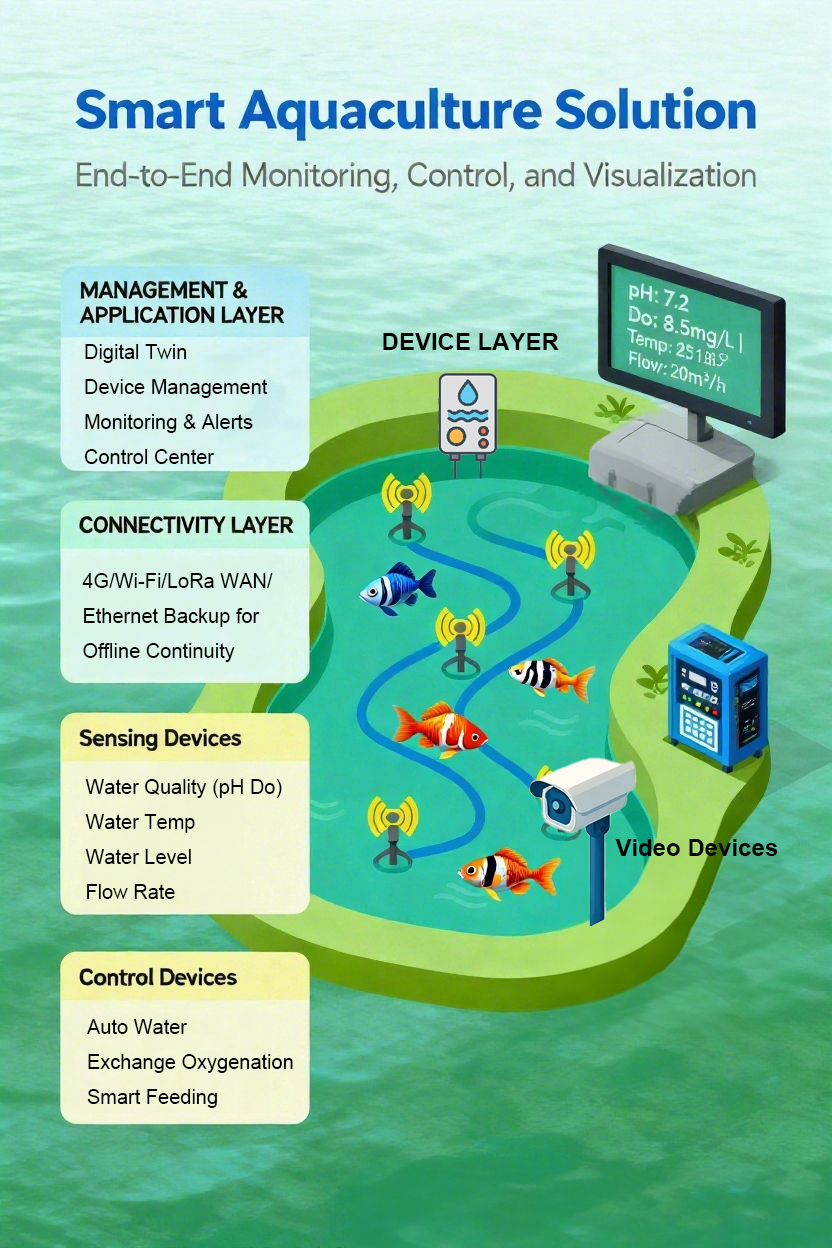[Comprehensive Report] At a modern crab farming base in Wuxi, Jiangsu Province, farmer Lao Li no longer needs to rely on experience like his predecessors, getting up in the middle of the night to observe water color by the pond edge, worrying about oxygen deficiency. His mobile phone displays the “underwater changes” in real-time, 24/7, for each pond: dissolved oxygen, pH, water temperature, ammonia nitrogen levels… All of this is thanks to the “sentinels” deployed underwater—water quality sensors. This is a snapshot of how China, the world’s largest aquaculture producer, is leading an industry transformation through Internet of Things (IoT) technology.
Moving Beyond “Rule of Thumb”: A Data-Driven Revolution in Aquaculture
Traditional aquaculture heavily relies on farmers’ visual observations and personal experience, which is high-risk and difficult to scale. Monitoring dissolved oxygen in water is particularly critical, as negligence can lead to “pond turnover,” causing devastating losses.
“I used to fear sudden weather changes in summer the most, but now I feel assured,” said Lao Li, pointing to the management platform on his phone. “Look, the dissolved oxygen in this pond is starting to drop slowly. The system has already issued an alert and automatically turned on the aerator. If we relied on manual observation, we would never detect such subtle but dangerous changes.”
Behind this lies an intelligent aquaculture solution centered on multi-parameter water quality sensors. These sensors are deployed long-term at different depths in the water, like loyal “underwater sentinels,” collecting crucial water quality data 24/7 without interruption.
In-Depth Solution Analysis: How the “Sentinels” Guard a Pond of Clear Water
- Real-Time Monitoring and Early Warning: High-precision sensors can detect minute fluctuations in key indicators such as dissolved oxygen, temperature, pH, turbidity, conductivity (salinity), and even ammonia nitrogen and nitrite levels. Data is transmitted to a cloud platform via wireless networks. If any indicator exceeds the preset safety threshold, the system immediately sends an alert to the farmer via mobile app, SMS, or other means.
- Smart Linkage and Automatic Control: The essence of the solution lies in the closed loop of “sensing-decision-execution.” When a dissolved oxygen sensor detects levels falling below a critical value of 4 mg/L, the system doesn’t just alarm; it automatically issues a command to start the aerator, continuing until water quality returns to normal. This achieves a fundamental shift from “reliance on human vigilance” to “reliance on technical prevention,” effectively mitigating farming risks during nighttime and extreme weather events.
- Data Analysis and Precision Feeding: Long-term data collected by the sensors is analyzed using AI algorithms, uncovering deep-seated patterns between fish feeding behavior, water temperature, and dissolved oxygen. Based on these models, the system can automatically activate feeders during optimal environmental conditions and control the feeding amount. This significantly improves feed utilization rates, reduces pollution from residual feed, and prevents water quality degradation at the source.
- Full Traceability of the Farming Process: All water quality data is completely recorded, creating a “digital file” for each batch of aquatic products. By scanning a QR code, consumers can not only learn about the product’s origin but also see the water conditions during its growth period. This provides a strong data-backed guarantee for food safety, greatly enhancing product credibility and added value.
Industry Impact and Future Outlook: From “Potted Landscape” to “Vast View”
This technology solution, centered on water quality sensors, is spreading from large-scale farming enterprises to ordinary farmers, evolving from “demonstration projects” into a widespread “industrial landscape.”
“The cost of the technology is continuously decreasing, and the benefits it brings are clear: it can reduce feed costs by approximately 15% on average, decrease disease incidence by over 30%, and increase unit yield by 20%,” introduced a manager from an aquaculture technology company. “More importantly, it makes farming predictable and controllable, attracting more young, highly educated talent to this traditional industry.”
On a broader sustainability level, online monitoring of effluent water quality ensures compliant discharge. Simultaneously, precision management significantly reduces medication use, promoting the development of eco-friendly aquaculture.
Experts point out that as a global leader in aquaculture, China, through its practice of “Sensors + IoT,” is providing a viable path for the global industry to address challenges related to resources, the environment, and food safety. These “blue waters” tended by digital technology are nurturing not only higher-quality aquatic products but also new hope for global food security and sustainable development.
We can also provide a variety of solutions for
1. Handheld meter for multi-parameter water quality
2. Floating Buoy system for multi-parameter water quality
3. Automatic cleaning brush for multi-parameter water sensor
4. Complete set of servers and software wireless module, supports RS485 GPRS /4g/WIFI/LORA/LORAWAN
For more water sensor information,
please contact Honde Technology Co., LTD.
Email: info@hondetech.com
Company website: www.hondetechco.com
Tel: +86-15210548582
Post time: Nov-06-2025


